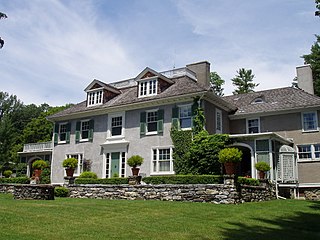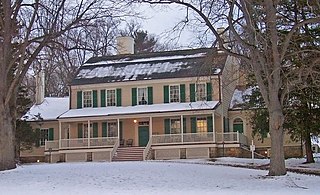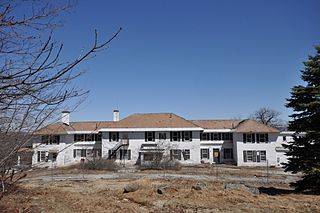
The John Quincy Adams Birthplace is a historic house at 141 Franklin Street in Quincy, Massachusetts. It is the saltbox home in which the sixth United States President, John Quincy Adams, was born in 1767. The family lived in this home during the time John Adams helped found the United States with his work on the Declaration of Independence and the American Revolutionary War. His own birthplace is only 75 feet (23 m) away, on the same property.

The Franklin Pierce Homestead is a historic house museum and state park located in Hillsborough, New Hampshire. It was the childhood home of the fourteenth president of the United States, Franklin Pierce.

The Webster Telephone Exchange Building is located in North Omaha, Nebraska. It was designed by the well-known Omaha architect Thomas Rogers Kimball. After the Easter Sunday Tornado of 1913, the building was used as the center of recovery operations. In 1933, American Bell donated the building to the Omaha Urban League.

The Noah Webster House is a historic house museum located at 227 South Main Street, West Hartford, Connecticut. It was the home of American lexicographer Noah Webster (1758-1853), and was declared a National Historic Landmark in 1962.

Schuyler Mansion is a historic house at 32 Catherine Street in Albany, New York. The brick mansion is now a museum and an official National Historic Landmark. It was constructed from 1761 to 1765 for Philip Schuyler, later a general in the Continental Army and early U.S. Senator, who resided there from 1763 until his death in 1804. It was declared a National Historic Landmark on December 24, 1967. It is also a contributing property to the South End–Groesbeckville Historic District, listed on the National Register of Historic Places in 1984.

Chesterwood was the summer estate and studio of American sculptor Daniel Chester French (1850–1931) located at 4 Williamsville Road in Stockbridge, Massachusetts. Most of French's originally 150-acre (61 ha) estate is now owned by the National Trust for Historic Preservation, which operates the property as a museum and sculpture garden. The property was designated a National Historic Landmark in 1965 in recognition of French's importance in American sculpture.

The John Jay Homestead State Historic Site is located at 400 Jay Street in Katonah, New York. The site preserves the 1787 home of Founding Father and statesman John Jay (1745–1829), one of the three authors of The Federalist Papers and the first Chief Justice of the United States. The property was designated a National Historic Landmark in 1981 for its association with Jay. The house is open year-round for tours.

The John Paul Jones House is a historic house at 43 Middle Street in Portsmouth, New Hampshire. Now a historic house museum and a National Historic Landmark, it is where American Revolutionary War naval hero John Paul Jones, resided from 1781-82 when it was operated as a boarding house. He also lived in a home in Fredericksburg, Virginia, on Caroline Street, owned by his brother.

Salmon P. Chase Birthplace was the birthplace and childhood home of Salmon P. Chase. It is located about 8 miles (13 km) north of Claremont on New Hampshire Route 12A. The 2+1⁄2-story wood-frame house was built c. 1790, and is a multi-section structure in an L shape. The main block is five bays wide and two deep, with a centered entry that has Greek Revival pilasters on the central entry and on the corners. This block faces west, and two narrower sections extend east from the rear. The first of these sections is also 2+1⁄2 stories, with two chimneys. The easternmost section is 1+1⁄2 stories, and was originally connected to a barn. The house is believed to be well-preserved, but there is no documentary evidence of its appearance in the early 19th century, and it is known to have been moved across the street from its original site in about 1848.

The Moffatt-Ladd House, also known as the William Whipple House, is a historic house museum and National Historic Landmark in Portsmouth, New Hampshire, United States. The 1763 Georgian house was the home of Founding Father William Whipple (1730–1785), a signer of the Declaration of Independence and Revolutionary War general. The house is now owned by the National Society of Colonial Dames in New Hampshire, and is open to the public.

Rokeby Museum is a historic farm property and museum at 4334 United States Route 7 in Ferrisburgh, Vermont. The 90-acre (36 ha) property includes a 1780s farmstead, and eight agricultural outbuildings with permanent exhibits. Hiking trails cover more than 50 acres (20 ha) of the grounds. Rokeby is open from mid-May to mid-October each year. The property was designated a National Historic Landmark in 1997 for its association with Rowland T. Robinson, a Quaker and ardent abolitionist who openly sheltered escaped slaves at Rokeby as part of the Underground Railroad. Robinson's extensive correspondence is an essential archive giving insight into the practices of abolitionists and the operations of the railroad.

The Daniel Webster Law Office and Library, also known as Daniel Webster Law Office, is a National Historic Landmark on the grounds of the Isaac Winslow House at 64 Careswell Street in Marshfield, Massachusetts. The office was built in 1832 for Daniel Webster as part of his expansive Marshfield estate. It housed part of his collection of law and agricultural books, and served as a retreat from the main house. It was designated a National Historic Landmark in 1974, and is listed on the National Register of Historic Places.

The Thomas–Webster Estate is a historic estate at 238 Webster Street in Marshfield, Massachusetts. It is most notable for its association with the politician and statesman Daniel Webster, who owned a large property in Marshfield, and is buried here along with other members of his family. The core of the estate was a farmstead Webster purchased from Nathaniel Thomas in 1832. Webster was known for his interest in agricultural science, and he made his farm one of the most productive in the area. Webster's house burned down in 1878, but a new house was built on its foundations. The property includes a number of landscape features designed by Webster, as well as the site where his small law office building stood during his lifetime.

The Concord Civic District consists of a collection of local and state civic buildings centered on the New Hampshire State House in Concord, New Hampshire. In addition to the State House, the district includes the Legislative Office Building, New Hampshire State Library, Concord City Hall, Concord Community Center, New Hampshire Historical Society, State House Annex, and the Concord Public Library. It also includes statuary and memorial objects placed on the grounds of the State House. The buildings, although architecturally different, are predominantly made out of locally quarried granite, and their grounds are landscaped in similar ways. The district was added to the National Register of Historic Places in 1983.

The New Hampshire Bank Building is a historic commercial building at 22-26 Market Square, Portsmouth, New Hampshire. Built in 1803 and much altered since, it is one of the nation's oldest purpose-built bank buildings, and was until 1977 the oldest building used continuously to house banking operations. It was added to the National Register of Historic Places in 1979.
Ebenezer Webster was a United States farmer, innkeeper, militia member, politician and judge. He was the father of Daniel Webster, a noted lawyer and orator who served in the United States Congress, as United States Secretary of State, and in other offices.

Beech Hill is a historic former summer estate off New Harrisville Road in Dublin, New Hampshire. The centerpiece of the estate, and its only major surviving element, is a large Georgian Revival mansion with hip roof and wide projecting eaves, which has views of the surrounding area. The mansion was listed on the National Register of Historic Places in 1983. It remains in private hands, but most of the surrounding estate is now local conservation land, with public hiking trails.

Daniel Webster Birthplace State Historic Site is a state park and historic house museum in Franklin, New Hampshire. It preserves the two-room log cabin associated with the 1782 birth and early childhood years of Daniel Webster, a noted orator and statesmen. The restored house reflects late 18th-century farm life. The house is open seasonally on weekends.




















